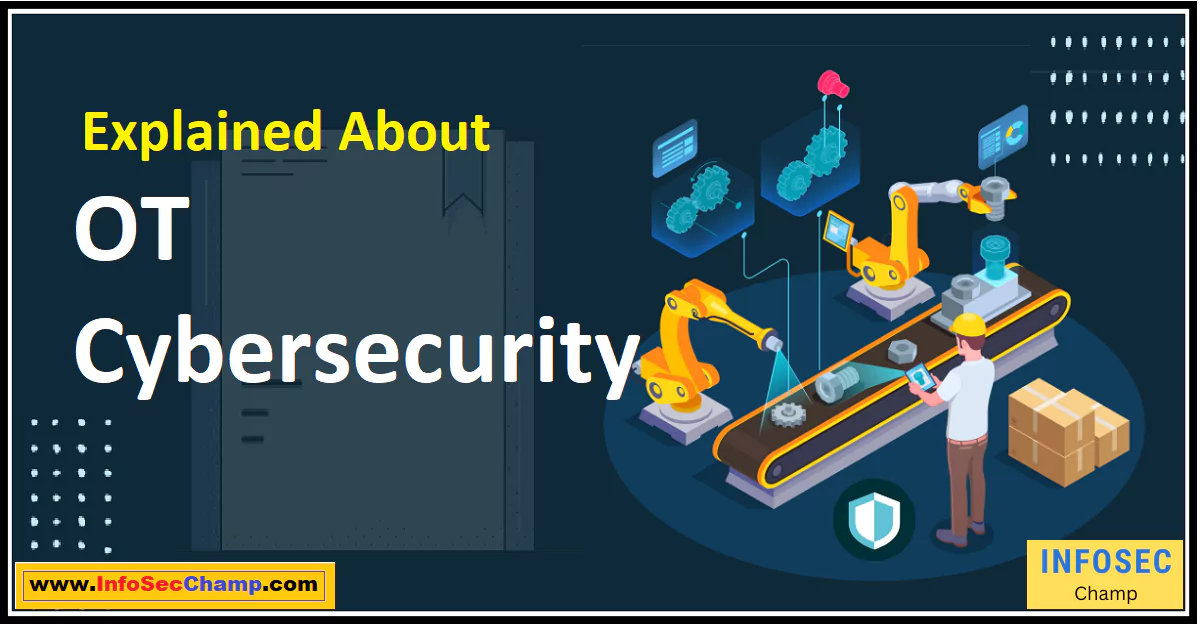OT Cybersecurity has become a ticking time bomb for manufacturers. Legacy industrial control systems and simplistic “air gap” thinking have left operational networks highly vulnerable to cyber-attacks. Threat actors are now sophisticated enough to breach industrial controls and wreak real havoc. The real-world impacts of an attack on critical infrastructure like manufacturing OT could be absolutely devastating.
While IT networks have been hardened over the years, OT cybersecurity has lagged dangerously behind. Manufacturers must take action immediately to assess and upgrade vulnerable industrial control systems. The threats are escalating rapidly. OT cybersecurity can no longer be an afterthought. It demands urgent attention and substantial resources to avoid catastrophe. Manufacturers who keep ignoring OT cybersecurity do so at their own peril. The risk is exploding and inaction will prove very costly indeed. The time for action on OT cybersecurity is NOW.
Outdated Systems Ripe for Attack
- Many OT systems still rely on outdated legacy hardware and software that lacks modern cybersecurity capabilities. These outdated ICS, SCADA systems, PLCs, and RTUs were never designed with cybersecurity in mind, leaving them highly vulnerable to today’s sophisticated attacks.
- Legacy OS like Windows XP and unpatched firmware create backdoors for threat actors to exploit. Outdated hardware has no memory protection or system isolation.
- Modern malware and hacking tools can easily breach these antiquated systems. Retiring legacy systems may not be feasible, but segmenting them and applying strict access controls is critical.
- Performing risk assessments of outdated equipment and mitigating risks through network segmentation, patching, and monitoring must be priorities for improving OT cybersecurity.
Air Gaps Are Not Enough
- Many assume air-gapped OT networks are inherently secure. But air gaps alone are proving insufficient against modern attacks.
- Threat actors use phishing, infected removable media, compromised vendors, and insider threats to bridge air gaps and penetrate OT.
- Stuxnet and TRITON are prime examples of how air gaps get jumped to trigger catastrophic outcomes.
- While still useful security layers, air gaps give a false sense of security. Robust cybersecurity needs layered defenses combining policies, technologies, and continuous vigilance.
- Air-gapped networks still need monitoring to detect anomalous behaviors that indicate a breach. Never assume an air gap means 100% secure.
Threat Actors Targeting OT Networks
- Historically OT networks were not heavily targeted. But this is changing rapidly as threat actors shift focus to vulnerable industrial control systems.
- Nation-states like Russia and China see manufacturing OT as attractive critical infrastructure targets for cyber warfare.
- Cybercriminals seek financial gain by threatening production. Hacktivists and insider threats pose risks too.
- Unsecured OT provides a soft target as attackers up their game with ransomware, supply chain attacks, and ICS-tailored malware like TRITON.
- Manufacturers are especially attractive targets due to lax OT security and potential safety and economic impacts from disrupting operations.
- With IT networks hardening, manufacturing OT networks look increasingly easy pickings to malicious groups.
Real-World Impacts Are Catastrophic
– Successful attacks on manufacturing OT systems could have catastrophic physical impacts in the real world.
– ICS malware like Stuxnet has already damaged equipment like centrifuges. Similar attacks could severely damage expensive industrial machinery leading to costly downtime.
– Worse still, compromised industrial processes could cause environmental releases, explosions, fires or threats to human safety.
– Ukraine power grid attacks show the potential for shutdowns that could cripple manufacturing operations and revenue. The fallout goes beyond data theft into the physical domain.
– While cyber-attacks look for information, compromising OT looks to control processes and equipment with potentially devastating kinetic impacts. Manufacturers must recognize the uniquely dangerous risks to industrial control systems.
Legacy ICS Highly Vulnerable
- Legacy industrial control systems (ICS) and supervisory control and data acquisition (SCADA) devices still used in manufacturing OT bear little resemblance to secure modern IT systems.
- They lack fundamental security capabilities like encryption, identity management, patch management, and system hardening that are standard in IT.
- Built for reliability and uptime, ICS/SCADA emphasizes availability over security. Their proprietary operating systems are rarely patched and not designed to be locked down.
- Exposed serial ports, unprotected PLCs, and insecure remote access protocols are common. Weak default passwords and accounts are routinely left unchanged.
- All this makes OT systems intrinsically far more vulnerable to attacks than IT networks. Legacy ICS must be shielded with stringent network segmentation and monitoring to offset inherent weaknesses.
OT Networks Lag Behind IT Security
– While IT systems have been fortified with layered cybersecurity defenses, OT network security has severely lagged behind.
– IT benefits from security standards and regulations that haven’t covered OT systems. Centralized IT teams handle security, while OT security is often left to plant engineers focused on operations.
– Result is OT networks lack the security technology stacks common for IT like IDS/IPS, SIEM, EDR, vulnerability management, and advanced endpoint protection.
– Immature OT cybersecurity programs also lack the policies, awareness training, and response planning standardized for IT groups.
– With weak security controls and limited expertise applied to OT, industrial networks present a soft target. OT security urgently needs to catch up with IT standards to counter escalating threats.
Urgent Assessments Needed Now
– Most manufacturers still lack visibility into their true OT cyber risk exposures – making assessments an urgent priority.
– ICS asset inventories, network architecture maps, and vulnerability assessments are needed to understand OT security gaps.
– Risk analyses should gauge potential business impacts from compromised OT including safety, reliability, compliance, and financials.
– Assessments should cover technology vulnerabilities but also account for unwritten OT policies and limited security expertise.
– Partnering with OT cybersecurity specialists can accelerate accurate assessments of current risk levels.
– Assessment insights create data-driven roadmaps for upgrading defenses before disaster strikes. The time window is closing rapidly.
Substantial Resources Required
- Improving manufacturing OT cybersecurity cannot be done on the cheap. Substantial financial and personnel resources are required for success.
- New technology investments are needed for IDS, network micro-segmentation, physically isolated backup systems, and modern security platforms.
- Dedicated in-house OT security staff will be essential for sustained improvements – one-time consulting won’t cut it. Hiring, training, and retaining talent will be ongoing challenges.
- Competing priorities and constrained budgets can’t be excused for deferring urgently needed OT security programs. The consequences of waiting will only compound.
- OT security needs its own budget line item and staff – it can’t just be a side responsibility any longer. Manufacturers must commit adequate resources commensurate with the rapidly rising risks.
Patching and Segmentation Critical
- Two of the most critical best practices for manufacturing OT security are network segmentation and keeping devices patched.
- Micro-segmentation creates secure zones isolating key systems and restricting lateral movement after breaches. This strategy limits impacts and prevents propagation.
- Regular patching closes vulnerabilities in controllers, HMIs, servers, and computers accessed for troubleshooting. Unpatched assets present easy targets.
- For legacy systems that can’t be patched, use application whitelisting and memory protection to prevent exploitation.
- Segmentation and patching are pragmatic starting points to make gradual OT security improvements while working within operational constraints.
Action Mandatory to Avoid Disaster
– Further deferring action on OT cybersecurity is a recipe for disaster. Manufacturers cannot afford to wait any longer.
– With threats rising exponentially and most OT systems highly vulnerable, problems will keep compounding without urgent intervention.
– The crushing costs of downtime, repairs, legal liabilities, and reputational damage after an attack will dwarf preventative spending.
– The time for studies, roadmaps, and future budget cycles has passed. Concrete actions to identify and reduce risks must commence immediately.
– Partner with internal stakeholders and OT security specialists to finally make substantial, measurable improvements – before catastrophe strikes. The window for action is now.
Complacency the Greatest Danger
– With lax security and limited visibility into OT risks, complacency may be the greatest danger manufacturing OT currently faces.
– Assuming “we’re secure” without evidence or clinging to legacy thinking invites disaster. No organization is immune from a determined, skilled attacker.
– Modern cyber threats are simply too advanced and adaptable to be stopped without vigorous security programs tailored to OT environments.
– Yesterday’s piecemeal quick fixes and half-measures cannot stem the rising tide. Manufacturers must be relentless in critically evaluating and improving defenses.
– Combat complacency through education, emergency drills, penetration testing, and openness to new analytics that provide objective visibility into OT security postures.
Don’t Become a Cyber Headline
- Manufacturers should think carefully about the headline risks before an avoidable OT cyber disaster puts them in the public spotlight:
- “Production Halted from Ransomware Attack”
- “Fined $10 Million Over Safety Lapses Tied to Cyber Attack”
- “Hacked Sensors Led to Massive [Company] Chemical Leak”
- These headlines expose manufacturers to financial costs, legal liabilities, damaged trust, and loss of life – all from preventable incidents.
- The time to avoid these damaging headlines is now, before disaster strikes. Manufacturers who wait risk their name becoming the next cautionary tale of overlooked OT cyber risks.
- Don’t end up as the next cyber headline or case study of preventable catastrophe. Take action and investment in OT cybersecurity seriously today.

Best 21 OT Cybersecurity Practices Manufacturers Must Follow Immediately
- Perform risk assessments of vulnerabilities, the likelihood of an attack, and potential impacts
- Implement network segmentation between IT and OT, amongst OT zones, and for remote access
- Harden OT components like controllers, RTUs, and HMIs by closing unneeded ports, removing unnecessary software/services, and applying password policies
- Maintain complete, accurate inventories of all assets connected to industrial control networks
- Establish effective, well-trained CERTs to monitor networks and respond to detected incidents
- Control access with the principle of least privilege plus multi-factor authentication
- Maintain up-to-date patching on all possible assets to eliminate vulnerabilities
- Isolate safety instrumented systems (SIS) to protect availability during attacks
- Install modern security platforms like antivirus, EDR, asset management, SIEM, and firewalls designed for ICS environments
- Create backups and disaster recovery plans for rapid restoration after incidents
- Develop comprehensive OT-specific policies and procedures securing the human element
- Implement continuous network monitoring tools optimized to detect ICS anomalies
- Establish remote access policies governing strict parameters for vendor access
- Perform regular penetration testing to validate the effectiveness of defenses
- Provide all personnel with OT-specific cybersecurity training to promote secure practices
- Enforce strict supply chain risk management for third parties integrated into OT networks
- Update incident response plans with steps tailored specifically for industrial control system contingencies
- Establish an OT SOC with threat intelligence feeds to proactively identify emerging risks
- Obtain cyber insurance tailored to OT environments to transfer financial risks
- Maintain compliance with all ICS cybersecurity regulations like NERC CIP
- Develop a proactive culture of cyber resilience and continuous security improvement for OT Cybersecurity
Invest Now or Pay More Later
– Manufacturers face a clear choice: invest in OT cybersecurity now or pay even more after an inevitable attack later.
– With threats rising, costs to recover from an incident will greatly exceed current costs to prevent it. There is no other path to avoid astronomical loss and damage down the road.
– Investing today in skilled staff, security platforms, network upgrades, and managed services will seem minor relative to outage costs that can quickly run into millions – not to mention legal liabilities and brand damage.
– It is not a question of “if” but “when” threat actors successfully attack manufacturing OT systems. When disaster strikes, those who have prepared will contain damages and recover more quickly.
– Manufacturers who keep deferring OT security improvements are guaranteeing preventable pain down the road. The time to invest is now.
Help Available from Experts
– Manufacturers need not tackle OT cybersecurity challenges alone. Knowledgeable partners can guide urgent security improvements.
– Experienced MSSPs offer 24/7 threat monitoring, incident response, assessments, and advisory services tailored to OT environments.
– ICS cybersecurity consultants can assist with in-depth risk analyses, vulnerability assessments, architecture design, policy development, and technology implementations.
– IT security firms offer OT-specific solutions for micro-segmentation, encryption, endpoint hardening, access control, and AI-powered threat detection.
– Leverage outside specialists to accelerate OT cybersecurity initiatives. They offer deep expertise manufacturers often lack internally today for OT Cybersecurity.
Start with an OT Cybersecurity Audit
– A thorough, independent OT cybersecurity audit by experts is the ideal starting point for securing manufacturing systems.
– Audits evaluate current policies, staff practices, network designs, and technology controls compared to security best practices.
– Gaps identified through audits provide data-driven roadmaps for improvement priorities and investments.
– Audits also establish important baselines for measuring progress over time as new defenses are implemented.
– While audits can feel invasive, their insights are invaluable for revealing true OT risk levels. Audits are constructive steps toward better security.
Implement Multilayered Defenses
– Effective OT cybersecurity requires multiple layers of protection technologies, not just one silver bullet.
– Multilayered models combine practices like network segmentation, multi-factor authentication, endpoint hardening, application whitelisting, system monitoring, and encryption.
– Laying comprehensive technical controls makes it far harder for attackers to fully penetrate defenses and cause damage.
– No single product can prevent all intrusions. But integrated layers can reduce risks, detect anomalous behaviors faster, and mitigate impacts.
– The more types of security solutions in place, the more hoops cyber criminals must jump through to achieve their aims for OT Cybersecurity.
Promote a Culture of Security
– Technology alone cannot secure OT environments. People are a vital element through policies, training, and culture.
– Operators, engineers, and vendors accessing OT systems must have security mindsets, not just operations focus.
– Clearly defined policies, regular training, and accountability measures promote secure behaviors. Psychological buy-in is critical.
– Leadership must demonstrate commitment to security and steer investments toward OT protections.
– A culture recognizing cyber risks and focusing on resilience is powerful prevention. Combine technology with engaged people to maximize manufacturing OT cybersecurity.
Continuous Monitoring Essential
– Static defenses alone will eventually be circumvented. Continuous monitoring for threats is essential to keep pace with attackers.
– 24/7 monitoring provides visibility into both external and internal OT activity to rapidly identify security events.
– Sophisticated analytics powered by machine learning baselines normal network patterns and alerts on deviations that could signify cyber threats.
– Monitoring detects threats missed by prevention tools and responds before small anomalies become big incidents.
– Ongoing vigilance through monitoring is critical for threat awareness and response agility. It is foundational for resilient OT security programs for OT Cybersecurity.
Conclusion
The risks of overlooking OT cybersecurity in manufacturing are escalating rapidly. Legacy systems and inadequate protections have left operational networks highly exposed to breaches by motivated, skilled adversaries. The potential impacts of compromised industrial controls range from costly downtime to catastrophic safety failures. Manufacturers can no longer afford to relegate OT security as an afterthought.
The urgent focus must be placed on assessing and reducing risks through strategies like network segmentation, patching vulnerable devices, security monitoring, policies promoting resilience, and dedicated resources. Though improving security requires investment, the costs of inaction and potential disaster far outweigh preventative measures. Manufacturers must act decisively now to avoid becoming the next headline of an OT cyber catastrophe that proper precautions could have prevented. There is no time to waste in rolling out robust, layered defenses before threat actors strike. Resolve now to finally make OT cybersecurity an urgent priority.

FAQs
Q: Why is OT security important?
A: OT security is critical because compromised industrial controls can cause production shutdowns, equipment damage, environmental incidents, and threats to human safety beyond just data theft.
Q: What are the risks of poor OT security?
A: Risks include operational disruptions, physical damage, regulatory fines, financial costs, legal liabilities, and reputational harm that could have been avoided with proper cybersecurity controls.
Q: How can manufacturers improve OT cybersecurity?
A: Strategies like network segmentation, legacy system upgrades, security monitoring, access controls, patching, and security training focused on the unique needs of OT environments.
Q: What are examples of OT cyber attacks?
A: Stuxnet, TRITON, Ukraine power grid attack. These exploited ICS vulnerabilities to cause physical destruction and outages.
Q: Why has OT security lagged behind IT security?
A: Less regulation, different operating priorities, distributed control networks, and a lack of cybersecurity expertise focused on industrial control systems.
Q: What are air gaps in OT security?
A: Physically isolating ICS networks from other systems, but air gaps alone are increasingly insufficient protection.
Q: Who poses threats to manufacturing OT systems for OT Cybersecurity?
A: Nation-state actors, cybercriminals, hacktivists, and insiders all pose increasing risks as they target industrial control systems.
Golden Quotes
“OT security can no longer be an afterthought in Industry 4.0.”

